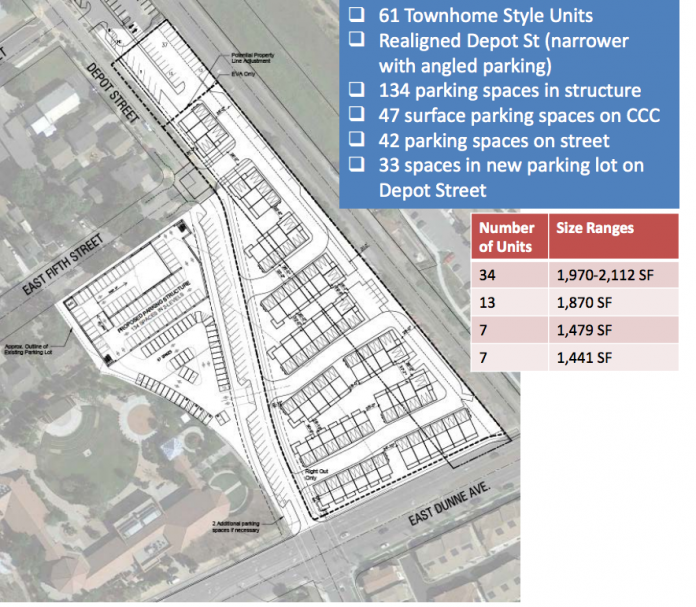
Unable to reach a consensus on the benefit of realigning Depot Street with Church Street on the edge of downtown, the Morgan Hill City Council Feb. 15 tabled a decision on the project that would have also added more than 60 townhomes on the Hale Lumber site.
The council and city staff gave no indication when the project might return for further discussion or approval.
The complex project would have rerouted Depot Street from Fifth Street, to the south where it would line up with Church Street at the existing traffic light at East Dunne Avenue. This new stretch of Depot Street would have cut through the Community and Cultural Center’s existing parking lot.
To make up for this loss of public parking (a total of 256 spaces), the developer promised to construct a two-level parking structure on the northwest side of the existing CCC parking lot, and install angled parking on the new Depot Street segment. The developer, Brookfield Residential Properties, planned to sell a portion of the Hale Lumber site to the city for additional public parking.
The loss of the CCC parking area for popular community events such as the Mushroom Mardi Gras and Friday Night Music Series was a concern the city and developer had not alleviated with the plans presented Feb. 15, according to discussion at the meeting.
MMG board member Bob Benevento told the council that the project would likely require the Memorial Day weekend festival to move to Monterey Road, which would add higher costs to close that road during the two-day event. Such costs could force the nonprofit to scale back its mission to provide scholarship money to local high school students, according to Benevento.
Morgan Hill Economic Development Manager Edith Ramirez tried to convince the council of the multiple public benefits of the project. It would create a smooth traffic flow from Depot to Church Street through the east side of downtown; it would also relocate an existing industrial operation—Hale Lumber—out of downtown where city officials prefer a pedestrian-friendly neighborhood with higher-density housing, retail, dining and recreational uses, Ramirez explained.
Hale Lumber’s owners were on board with the development agreement between the city and Brookfield, which was presented to the council Feb. 15. Bob Hammond, one of the owners of Hale Lumber—located on the south end of Depot Street up to the intersection with East Dunne—told the council they have been trying to move out of the downtown for a long time. He has met with “at least” five developers over the years in an attempt to sell the site.
“If this doesn’t go through now, it won’t happen for a long time,” Hammond said.
In November 2016, the council approved a negotiating agreement with Brookfield on the street realignment/residential/parking project. The negotiations resulted in the project presented to the council Feb. 15.
Joe Guerra of Brookfield Residential also addressed the council Feb. 15. He said if they approved the agreement, the developer would work on the street and replacement parking before beginning construction on the proposed 61 townhomes where Hale Lumber is now. “We’re going to be highly motivated to build as quickly as possible—I don’t make any money when I’m making public improvements,” Guerra said.
Under the agreement, the city would have sold 1.6 acres (worth about $3 million) from the CCC parking lot and Depot Street right-of-way to Brookfield, which would have sold .3 acre (worth about $570,000) from Hale Lumber to the city. The city would have also contributed $2 million to complete the roughly $6.2 million worth of infrastructure improvements (including 200 temporary public parking spaces during construction of the new street and parking).
But a majority of the council questioned the need for the project’s chief goal—the realignment of Depot Street—even though it has been a long-term aim of city planning documents for several years.
Mayor Pro Temp Larry Carr said there is no evidence that realigning Depot Street to Church Street would alleviate downtown traffic by moving cars off Monterey Road, which is a busy commuter route that often slows to a crawl during rush hour.
“Maybe the goals that were valid 10 years ago or so are no longer valid,” Councilman Rene Spring added.
Parking is also a major concern among all four council members present Feb. 15 (Councilman Rich Constantine was absent from the meeting.) The officials have grown weary of a pattern of high-density residential projects throughout town not providing enough parking for residents and their visitors, which results in overflow parking on the streets or other public areas.
Nearly 20 people from the public spoke to the council about the project Feb. 15—most of them opposed.
Peter Mandel, speaking for the South Valley Civic Theater, said with the loss of parking at the CCC—even temporarily—would result in lower attendance and ticket sales for the theater group’s productions. SVCT performs at the Community Playhouse, which is located inside the CCC. He said the city has not contacted SVCT about the realignment/residential project.
Jonathan Brusco, a Gavilan College trustee, said he mentioned the city’s proposal at a board meeting this week and nobody in the room was aware of it. He accused city staff of lying or “not talking to the right people” when they said they have talked to Gavilan staff on site at the CCC campus.
Gavilan College has a satellite campus at the CCC, and is one of the facility’s most active tenants.
The accusation of lying prompted City Manager Steve Rymer to speak out. “That is absolutely not the case,” Rymer said. “We will follow up with that organization to make sure they are engaged.”
Councilmembers’ other concerns with the project include the impact on events such as the MMG and on some large oak trees that appear to be in the way of the new roadway plans.
City staff will reevaluate the importance of realigning Depot Street following the council’s tabling of the project.







